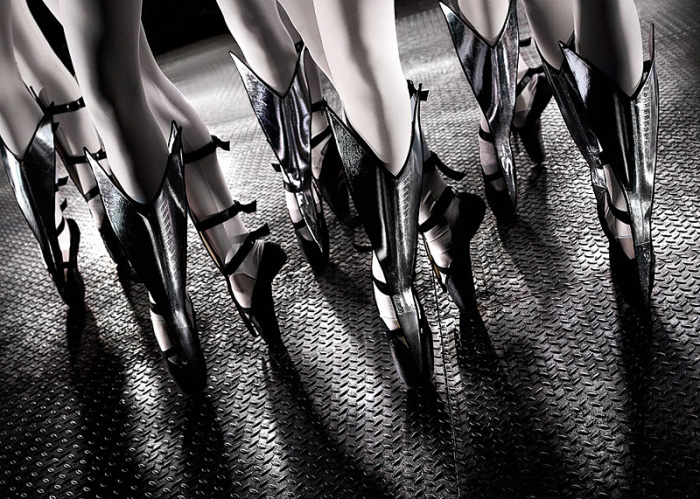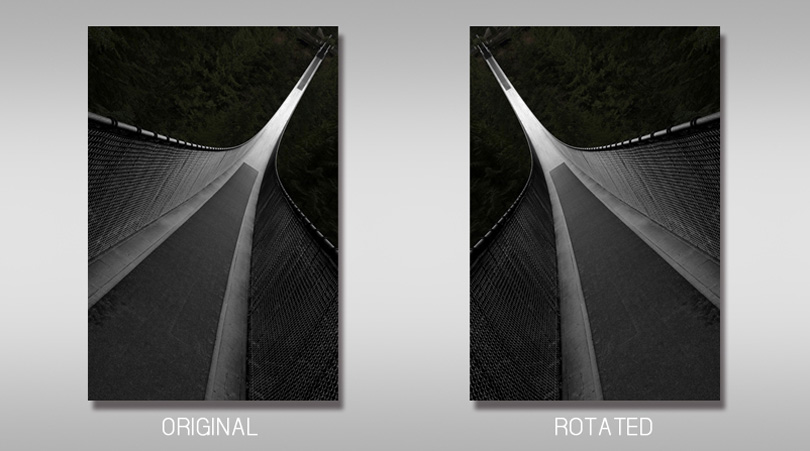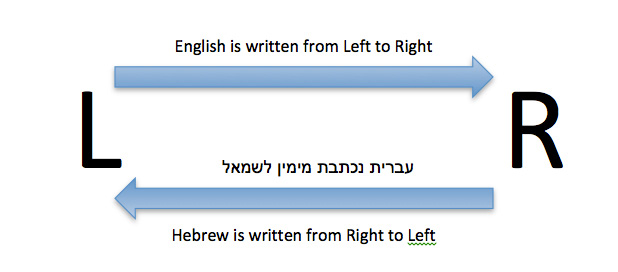

Left and Right Brain
In my previous article, Understanding the Left & Right Brain, posted on the site in October 2013, I discussed two major differences between the Left & Right Brain:
- The Left hemisphere is sequential, while the right hemisphere is simultaneous.
- Motoric skills of one side of the body are controlled by the contralateral part of the brain.
In that article I gave an example of image and showed how the affect of leading lines cater to our Left Brain rather than the Right and the optimal direction when choosing a composition would be to direct the viewers gaze from Left to Right which makes us prefer the image on the left below where the leading lines are directing our gaze from left to right rather than the flipped mirrored image.

I received quite a few responses to my article were people asked to make the claim that maybe we prefer this direction (left to right) due to our language in the west of reading from left to right. I replied to these people that I do make that argument in my book but decided to add it here as well.
To address the argument of langue I need to first explain a third difference in the way the two hemispheres of our brain work, and that is:
- The Left hemisphere specializes in text; the Right hemisphere specializes in context.
This can be explained through the tone of voice and context of a verbal conversation. The Left brain does not understand things like indirect language, or how the tone or cadence of the voice can convey irony or sarcasm. Therefore, emails and text messaging have a range of iconic emotions that try and fill in the unspoken innuendos. It does not understand how context is different from the literal meaning. The Left hemisphere handles what is said while the Right hemisphere focuses on how it is said. Neither side of the brain can do the job without each other; we need the text of our lives to be in context.
When applying this attribute to visual art, our mind can use its contextual Right brain thinking not just in verbal form but also in a visual realm.
In photography, our communication is through the limited boundaries of a frame. It is through this limited space in which we tell our visual story, we can choose what to include and what to exclude. Furthermore, in photography we are reducing reality from the three dimensional special world as we know it, to a flat two dimension image. This is where the strength of the Right brain comes in. The Right brain’s contextual ability can make sense of things without having to see the complete picture. From a partial image we can put together the rest of the story and deduct what the complete picture is about. This ability is strongly noticeable in Abstract Photography.


Now that we understand the three basic differences between the Left and Right hemisphere:
- Sequential vs. Simultaneous.
- Contralateral, each hemisphere controls the opposite side of the motoric movement of the body (including eye movement), and
- Text vs. Context
A legitimate question can be raised, since English speaking people are already ‘trained’ in reading from left to right, doesn’t that create a bias in their preference for linear sequential images where the leading lines guide your gaze from left to right? I say not and I will make my point.
In my ebook, Left & Right Brain, I open the discussion of the history of the development of written language and the ramifications it has to the way our minds work. Does the fact that our written language in the west is written left to right (Left brain) have any implications on the preference of the image we choose as seen in the example above of the Capilano Bridge. Or perhaps, is it the other way around, Indo-European languages have developed they way they have due to their full-contextual properties and thus just created a growth spurt in the Left brain?
To summarize the argument, and fast forward thousands of years of written language evolution, there are three main types of written languages:
- Fully contextual languages such as English in which we read a word exactly as it is spelled (due to vowels).
- Contextual languages such as Hebrew and Arabic in which the meaning of the word needs to be understood according to the context in which it is written. For instance, if you read “hd n th blk” in a story about someone having their head cut off, your mind would fill in the vowels as it reads “head on the block”, while in another context you might read it as “hid in the black”. Additionally, and this difference I find is a major difference, Semitic scripts are written from right to left. They activate the Right hemisphere of the brain (as explained in the contralateral difference of the two hemispheres, movement of the eyes to the left activates the Right hemisphere).
 3. Pictorial writings of languages as in Chinese and Japanese, are written from top to bottom. However, what happens when you reach the bottom of the column? Since pictorial illustrations are one visual,we see the simultaneous and two contextual, meaning. They are symbolic illustrations of a cognitive idea or object; they trigger Right brain thinking. Therefore, it is no surprise that pictorial languages such as Chinese and Japanese start at the right side of the page and advance to the left, activating the Right brain
3. Pictorial writings of languages as in Chinese and Japanese, are written from top to bottom. However, what happens when you reach the bottom of the column? Since pictorial illustrations are one visual,we see the simultaneous and two contextual, meaning. They are symbolic illustrations of a cognitive idea or object; they trigger Right brain thinking. Therefore, it is no surprise that pictorial languages such as Chinese and Japanese start at the right side of the page and advance to the left, activating the Right brain
Concluding My Argument:
Almost all pictographic systems favor vertical layout that advance to the left while most phonographic systems are horizontal. And, out of several hundred phonographic languages that have vowels, sequence languages, almost all are written toward the right (reading toward the right involves the Left hemisphere), while out of fifty languages that don’t have signs for vowels, contextual languages, all are written toward the left (reading towards the left involves the Right hemisphere). These numbers are too extreme to be coincidental.
As I have tried to prove above, written language systems have developed as they are today, due to the different nature of the Left and Right hemisphere. We prefer a photo that guides our gaze to the right through straight lines because it is our Left hemisphere’s innate nature and not because we read from left to right.
By understanding the different ways in which the two hemispheres of our brain work and how that affects our visual interpretation of art, you can develop and cultivate tools that will assist you to consciously see the world differently and help you improve on your intuitive compositional skills.
When you see the world differently, your images will be different

Lorem ipsum dolor sit amet, consectetur adipiscing elit, sed do eiusmod tempor incididunt ut labore et dolore magna aliqua. Ut enim ad minim veniam, quis nostrud exercitation ullamco laboris nisi ut aliquip ex ea commodo consequat. Duis aute irure dolor in reprehenderit in voluptate velit esse cillum dolore eu fugiat nulla pariatur. Excepteur sint occaecat cupidatat non proident, sunt in culpa qui officia deserunt mollit anim id est laborum.

Lorem ipsum dolor sit amet, consectetur adipiscing elit, sed do eiusmod tempor incididunt ut labore et dolore magna aliqua. Ut enim ad minim veniam, quis nostrud exercitation ullamco laboris nisi ut aliquip ex ea commodo consequat. Duis aute irure dolor in reprehenderit in voluptate velit esse cillum dolore eu fugiat nulla pariatur. Excepteur sint occaecat cupidatat non proident, sunt in culpa qui officia deserunt mollit anim id est laborum.
Lorem ipsum dolor sit amet, consectetur adipiscing elit, sed do eiusmod tempor incididunt ut labore et dolore magna aliqua. Ut enim ad minim veniam, quis nostrud exercitation ullamco laboris nisi ut aliquip ex ea commodo consequat. Duis aute irure dolor in reprehenderit in voluptate velit esse cillum dolore eu fugiat nulla pariatur. Excepteur sint occaecat cupidatat non proident, sunt in culpa qui officia deserunt mollit anim id est laborum.
Lorem ipsum dolor sit amet, consectetur adipiscing elit, sed do eiusmod tempor incididunt ut labore et dolore magna aliqua. Ut enim ad minim veniam, quis nostrud exercitation ullamco laboris nisi ut aliquip ex ea commodo consequat. Duis aute irure dolor in reprehenderit in voluptate velit esse cillum dolore eu fugiat nulla pariatur. Excepteur sint occaecat cupidatat non proident, sunt in culpa qui officia deserunt mollit anim id est laborum.

Lorem ipsum dolor sit amet, consectetur adipiscing elit, sed do eiusmod tempor incididunt ut labore et dolore magna aliqua. Ut enim ad minim veniam, quis nostrud exercitation ullamco laboris nisi ut aliquip ex ea commodo consequat. Duis aute irure dolor in reprehenderit in voluptate velit esse cillum dolore eu fugiat nulla pariatur. Excepteur sint occaecat cupidatat non proident, sunt in culpa qui officia deserunt mollit anim id est laborum.
Lorem ipsum dolor sit amet, consectetur adipiscing elit, sed do eiusmod tempor incididunt ut labore et dolore magna aliqua. Ut enim ad minim veniam, quis nostrud exercitation ullamco laboris nisi ut aliquip ex ea commodo consequat. Duis aute irure dolor in reprehenderit in voluptate velit esse cillum dolore eu fugiat nulla pariatur. Excepteur sint occaecat cupidatat non proident, sunt in culpa qui officia deserunt mollit anim id est laborum.
Lorem ipsum dolor sit amet, consectetur adipiscing elit, sed do eiusmod tempor incididunt ut labore et dolore magna aliqua. Ut enim ad minim veniam, quis nostrud exercitation ullamco laboris nisi ut aliquip ex ea commodo consequat. Duis aute irure dolor in reprehenderit in voluptate velit esse cillum dolore eu fugiat nulla pariatur. Excepteur sint occaecat cupidatat non proident, sunt in culpa qui officia deserunt mollit anim id est laborum.
Lorem ipsum dolor sit amet, consectetur adipiscing elit, sed do eiusmod tempor incididunt ut labore et dolore magna aliqua. Ut enim ad minim veniam, quis nostrud exercitation ullamco laboris nisi ut aliquip ex ea commodo consequat. Duis aute irure dolor in reprehenderit in voluptate velit esse cillum dolore eu fugiat nulla pariatur. Excepteur sint occaecat cupidatat non proident, sunt in culpa qui officia deserunt mollit anim id est laborum.

Lorem ipsum dolor sit amet, consectetur adipiscing elit, sed do eiusmod tempor incididunt ut labore et dolore magna aliqua. Ut enim ad minim veniam, quis nostrud exercitation ullamco laboris nisi ut aliquip ex ea commodo consequat. Duis aute irure dolor in reprehenderit in voluptate velit esse cillum dolore eu fugiat nulla pariatur. Excepteur sint occaecat cupidatat non proident, sunt in culpa qui officia deserunt mollit anim id est laborum.
You May Also Enjoy...
SM-Editing 101
A Weekly Column By Mike Johnston © Mike Johnston 2002 The little three-letter word "pro" (it aspires to be a four-letter word but comes up a
Jungle – Costa Rica
Please use your browser'sBACKbutton to return to the page that brought you here.
